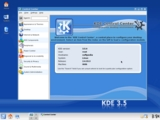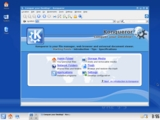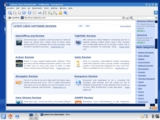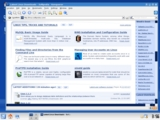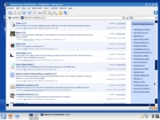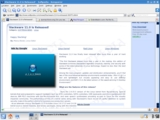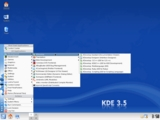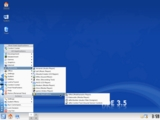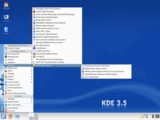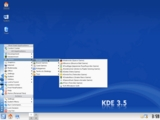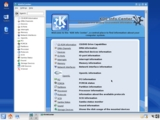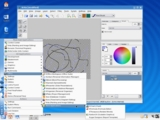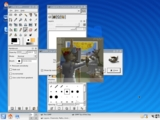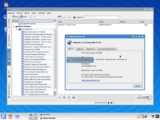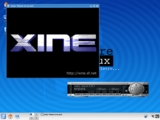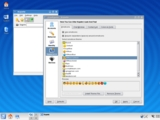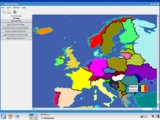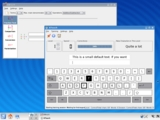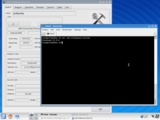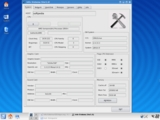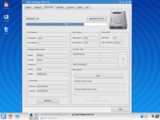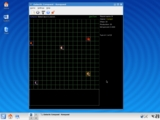My last contact with Slack was through version 9.2, if I remember correctly, but I got my hands on the new version of Slackware to see what it can do, and I have to admit that it's still the fastest distribution around. I didn't like the installer though, just because it's not GUI-based and it's in text mode, but it's very fast and simple to use. The text mode installer might be a problem for beginners that are used to click their way through a wizard. The big problem before the installation wizard is the cfdisk/fdisk harddisk partitioning part, where most of the beginners must read a How-to about that.
Well, I used cfdisk to make a Linux bootable partion and a SWAP one on an empty hard drive. After the partitioning part, you end up in the console again and all you have to do is to type 'setup', hit enter and the installer starts. Main Menu is the same as always, first option is HELP, where you'll find some help about the installation process if this is your first time installing Slackware; KEYMAP to map your keyboard if you didn't do that when the CD/DVD booted; ADDSWAP so you can choose and activate your SWAP partition (it's a good thing to activate it before you begin to install the packages, so it can run much faster); TARGET lets you choose the target hard drive partition where you want to install the system; SOURCE option allows you to select from where you install the system, CD-ROM, HARDDRIVE, FTP etc.; from the SELECT option we will choose what to install in our future Slackware system; INSTALL is the key to start the installation process and CONFIGURE will allow us to set or choose some options after the system has been installed.
Another difficult part for the beginner user is where you'll have to choose what type of kernel you want; for version 9.x, the default kernel was bare.i (standard ATA/IDE support) but I saw that now, the default one is sata.i. That?s a very good choice, as SATA drives are taking over the IDE disks. I've chosen to install (as recommended) everything. The installation was quick, but you can?t get a cup of coffee 'till it's done. After the packages are installed, you must do the configuration of the installed system, like network, date and time, what processes to start with the system, what would be the default desktop environment. Of course, I've chosen the KDE window manager as default desktop environment, as I am a big fan of KDE, but you can choose another one, like GNOME, XFCE or Fluxbox. I almost forgot about the LILO installation. I've always wondered why Slackware uses LILO, and not GRUB, or why not both, right? Well?you'll just have to settle with LILO as your Bootloader.
After the reboot (damn LILO is ugly) my new Slackware 11.0.0 machine started quick and fast, I've logged in and started the X server. KDE started automatically as I have optioned for, and there it is, my new Slack system. Man it's fast! The latest KDE 3.5.4 was a bit of a surprise, I must admit, as Slackware always uses only the stable version (the ones that they think are stable for Slackware) of packages. The latest 2.4 kernel (2.4.33.3) was on board, running very well. Of course the 2.16.18 kernel is still under hard testing, so it is not yet recommended for a Slackware machine, but if you really want a 2.16 kernel, you have the well-tested 2.6.17.13 kernel.
Let see what's under the hood on this version of Slackware:
? Kernel 2.4.33.3 - The perfect choice for running your production servers. ? Kernel 2.6.17.13 - When running a 2.6 kernel, Slackware supports udev, for creating devices in /dev dynamically ? System binaries are linked with the GNU C Library, version 2.3.6. ? X11R6.9.0 ? KDE 3.5.4 - The award winning desktop environment ? GCC 3.4.6 - The default C, C++, Objective-C, Fortran-77, and Ada 95 compiler. ? Support for fully encrypted network connections with OpenSSL, OpenSSH, and GnuPG. ? Apache 1.3.37 web server with Dynamic Shared Object (DSO) support, SSL, and PHP. ? PCMCIA, CardBus, and APM support for laptops. ? Perl 5.8.8 ? Python 2.4.3 ? Ruby 1.8.4 ? Subversion 1.4.0 ? KDE's Konqueror 3.5.4 ? The popular Firefox 1.5.0.7 ...and more more other new and exciting stuff!
Everything that I have tested on my new Slackware machine runs very well, no problems whatsoever. In conclusion, installation was fast and simple as usual, the system itself is even faster than anything I now at this moment. I recommend Slackware to everyone who likes a "fast ride". Got Slack?
You can download Slackware Linux now from Softpedia.

 14 DAY TRIAL //
14 DAY TRIAL // 